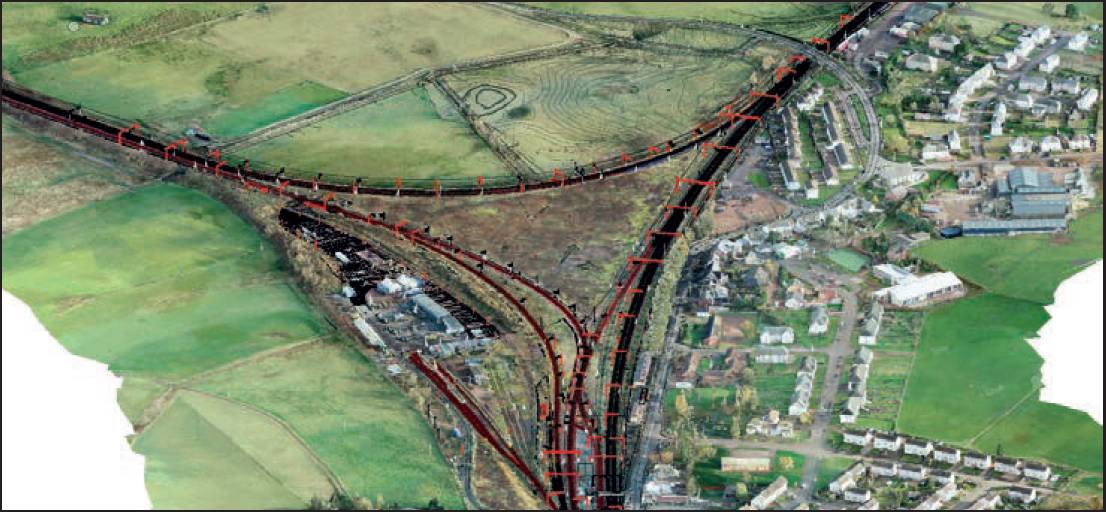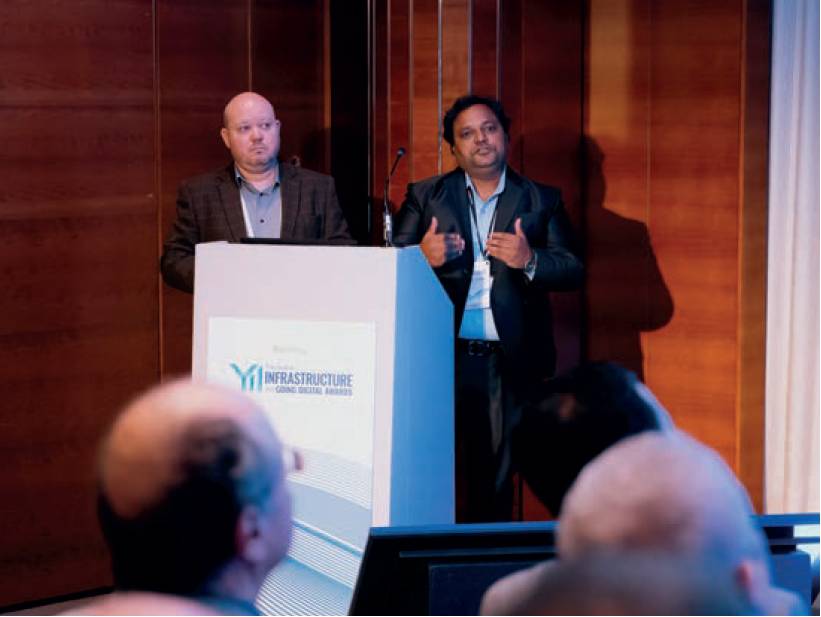Unblocking the bottleneck
Chris Conroy, Associate Technical Director – BIM Manager, Danny Keyes, Business Director Scotland and Northern Ireland, Prasad MN, Senior BIM Coordinator, and Santosh Kumar Chitti, Technical Discipline Lead, Arcadis, spoke to Danielle Kenneally

ARCADIS is known as a pioneer of digital planning and design innovation. Thanks to its work on upgrading the Carstairs junction in Scotland and its subsequent achievement as a Bentley Year in Infrastructure and Going Digital Awards 2022 finalist, the sustainable design, engineering, and consultancy company is leading the way in alternative approaches to design through the use of BIM.
It is something that has helped boost its productivity, improve sustainability, and transform operation processes to deliver increased reliability in the rail and transit industry.
Despite working during the pandemic across multiple countries, its work to improve passenger service, permit high-speed, low-emission electric trains, and accommodate freight trains without congestion, saw the Arcadis team create a shared digital twin of the project that would enable a decades-long work-in-progress to finally come to fruition. Members of that team spoke to the Civil Engineering Surveyor’s Danielle Kenneally about the project, its challenges, and what it was like to work across two different continents.
Tell us about yourselves and the Carstairs project you’ve been working on which was also your entry into Bentley’s Year In Infrastructure and Going Digital Awards 2022.
Santosh Kumar Chitti: The Carstairs Junction remodelling scheme is part of a multibillion-pound investment to improve Scotland’s railway. It’s located on the west coast mainline between Glasgow and London, linking with Edinburgh, and as one of the busiest junction in Scotland’s network it requires major improvement works. The work is being delivered through the Rail Systems Alliance Scotland that consists of Network Rail; who is the client and a partner, Babcock; the contractor and Arcadis; the principal designer.
The Carstairs Junction remodelling scheme is part of a multi-billion-pound investment to improve Scotland’s railway. We’re involved in delivering the major improvement works, which represents an investment of £164m in the junction to rationalise and simplify the track layout and modernise the signalling through one of the most critical sections of the Scottish rail network. It means re-configuring and renewing the existing track, along with associated signals and overhead electrification lines, plus improvements to the Carstairs railway station platform.
On completion, this will improve infrastructure reliability and line speeds on the west coast main line from 40mph now to 110mph and the new layout will also include the creation of Scotland’s longest freight loop accommodating 775m long freight trains.
Chris Conroy: The scheme will enable the separation of train station traffic allowing non-stopping trains to travel through at 110mph. It will clear up that bottleneck that was there and add resilience in the network. The freight separation design will also help – it’ll be the biggest freight loop in Scotland.
What challenges did you face and how did you overcome them and turn them into benefits?
Santosh Kumar Chitti: The main challenge for us was to improve reliability because the existing infrastructure is quite old, dating back to the 1950s, with the junction dating back even further to the Victorian era when it didn’t have the pressures it would have today, and it requires regular and costly maintenance work. The triangular junction manages traffic into Scotland from England, from the East Coast Mainline, the West Coast Mainline and provides a local service between Glasgow and Edinburgh.
More than 200 services pass through the junction on an average midweek day with 12 train and freight operators regularly using the route, so we also needed to ensure it remained operational during as much of the renewal as possible to minimise disrupting traffic on an already congested bottleneck.
Prasad MN: People usually just see 2D or 3D drawings, but the way we’ve approached this is in a 3D digital format enabling people to really visualise what’s being done on the site. Using BIM allows people to come onto the project aware of clashes before it has been constructed. It’s a huge benefit for those on site to have those resolved in the first instance, especially as the site remains in use.
Chris Conroy: The philosophy of this was to design a digitally coordinated project and that was a challenge in Scotland where it hadn’t been done to this scale and complexity previously. Getting the client and the contractor on board with that digital approach was a challenge. We succeeded though through a series of briefing sessions to ensure they understood why we were doing what we were doing, but also by demonstration. Just showing them what it’s like to have a digitally coordinated design and process really piqued their interest. Being able to solve issues before going in on the ground really encouraged them to invest in it.
Have other variations of this project then been tried before and not worked?
Chris Conroy: Network Rail has been trying to do a rationalisation of this junction for three decades and has never been able to achieve it because of impracticalities, including its disruption to passengers and freight and its cost-effectiveness. Our multidisciplinary digital coordination created the right environment to support an effective solution.
Santosh Kumar Chitti: It’s been optioned by Network Rail since the 1990s, but contractors weren’t able to resolve the challenges it posed.
What has the feedback been like so far and has this included input from those involved in past studies for the Carstairs Junction?
Chris Conroy: Network Rail has been involved throughout the development. We have had some great feedback within the project team, not just from Rail Systems Alliance Scotland but also from other companies who have invited us to do similar digital coordination exercises for other Network Rail projects in Scotland.
Santosh Kumar Chitti: It’s huge praise from the client to be asked to share our expertise and knowledge in digital coordination in other large scale projects.
Could you tell our members more about Rail Systems Alliance Scotland and how it is involved in the project?
The main challenge for us was to improve reliability because the existing infrastructure is quite old, dating back to the 1950s, with the junction dating back even further to the Victorian era when it didn’t have the pressures it would have today.Chris Conroy: My role is as BIM manager within the Rail Systems Alliance. It brings the client, the contractor and the designer together as one entity to deliver a framework of renewals and enhancements to Scotland’s railway. The alliance’s core delivery is track renewal and enhancement projects, including the use of BIM – we’re trying to improve digital maturity in the handling of projects with the Carstairs enhancement project a really a big opportunity for us to showcase what can be achieved.
Through the use of Bentley software we were able to demonstrate this. It’s also the reason why I hired Prasad, who came over from India, to run a programme of digital coordination exercises.
The early part of his involvement was undertaken online over MS Teams because of COVID-19 restrictions, but his work enabled us to develop the model, and work through the clashes, and resolve them. At the peak of our design, there were 101 designers working on the project in seven cities across Scotland, England and India.
What was it like to be brought into the design team from India, Prasad?
Prasad MN: I was excited to work on the project. While it was definitely tough to work from India at first because more people were based in and obviously continue to work in Scotland, once we got the communication and BIM approach on track, using Bentley software, it became a lot smoother. It meant that any person could work from India or from Scotland and access the digital models and that is what my role as senior BIM coordinator is about.

How has Bentley software been used throughout the project?
I was excited to work on the project. It was definitely tough to work from India at first because more people were based in and obviously continue to work in Scotland. Chris Conroy: At the core of it is Bentley ProjectWise and Bentley eB as a common data environment and central hub, set up for us by Network Rail. Then we’ve used Bentley’s MicroStation for 3D modelling and drawing production, and AECOsim and OpenBuildings Designer for structural and civils.
Plus, OpenRoads for earthworks modelling, Bentley Rail Track for rail geometry, OpenRail for rail 3D modelling, LumenRT for visualisations, Context Capture to generate spatially-classified and engineering-ready reality meshes, and iTwin to design, build, and operate digital twins of infrastructure assets.
Prasad MN: Initially we were facing a challenge that not everyone on the project team would have the knowledge, understanding and familiarity with CAD (computer aided design) applications to access and interrogate design, however, iTwin made it more accessible and easier for people to understand. A traditional 3D model would need a person to be familiar with CAD to know how to work it, whereas with iTwin, you don’t need to have any experience with it really, it’s easy to understand the context of your environment within the 3D model.
Carstairs is fundamental to the Scottish government’s decarbonisation programme – getting freight off the road and onto the railway. Great in theory, but if you don’t have infrastructure that enables it, it’s not going to happen.Danny Keyes: Bentley has been key to advancing our digital journey. The software has enabled us to share our vision because not everyone can imagine a 3D environment. It’s provided us with enough range for us to do everything that we wanted to do.
The undertaking of the project has been a real bugbear of Scotland for several decades and being able to design it, visualise it, and pull it together using the software, and, furthermore, make savings using BIM, made a huge difference to whether the project went ahead.
When will the design become reality and are you involved in plans to update further sites in the rail and transit industry?
Chris Conroy: We began the Carstairs Junction project back in 2019 and the major part of the delivery programme will be completed in the spring of this year. Over the last 18 months the preparatory works have undertaken 3km of track renewals, 1.5km of new drainage and installation of signalling and overhead line masts. The spring line closure will install 10km of track and 27 sets of switches and crossing that allow trains to move between tracks.
Danny Keyes: Carstairs Junction is fundamental to the Scottish government’s decarbonisation programme – getting freight off the road and onto the railway. Great in theory, but if you don’t have infrastructure that enables it, it’s not going to happen, so this is a fundamental part of that policy. We’re very pleased to be involved in other key projects in Scotland that will contribute to the government’s net zero carbon targets. They too, focus on getting more freight off the roads and to improve the passenger experience and we’re optimistic that we can use similar solutions to implement equivalent effective and economic results.
Chris Conroy, Associate Technical Director – BIM Manager, Danny Keyes, Business Director Scotland and Northern Ireland, Prasad MN, Senior BIM Coordinator, and Santosh Kumar Chitti, Technical Discipline Lead, Arcadis, spoke to Danielle Kenneally